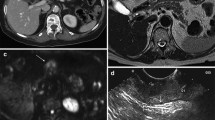Abstract.
Background: The purpose of this study was to assess the role of three-dimensional (3D) and axial imaging by spiral computed tomography (CT) in the evaluation of advanced gastric carcinoma (AGC).
Methods: Sixty patients with AGC underwent 3D and axial imaging by spiral CT. Among them, 40 cases were confirmed by surgery. The remaining 20 cases showed typical findings of AGC with upper gastrointestinal series and gastroscopy that were proved by endoscopic biopsy. Spiral CT was performed with 3-mm collimation, 4.5-mm/s table feed, and 1.5-mm reconstruction interval in the supine position after ingestion of gas. Three-dimensional images using the shaded surface display (SSD) technique were analyzed and graded (excellent, good, or poor). A second dual-phase spiral CT scan was performed with 5-mm collimation, 7-mm/s table feed, and 5-mm reconstruction interval in the prone position after ingestion of water.
Results: Among 60 cases of AGC, there were two cases (3.4%) of Borrmann type 1, 12 cases (20.0%) of Borrmann type 2, 32 cases (53.3%) of Borrmann type 3, 11 cases (18.3%) of Borrmann type 4, and three cases (5.0%) of Borrmann type 5. Of the 60 cases of AGC, excellent 3D images were obtained in nine patients (15.0%), good 3D images in 39 (65.0%), and poor 3D images in 12 (20.0%). Among the 12 patients with poor images, cancers were located at the pyloric antrum in eight cases (66.7%), were AGC Borrmann type 4 in three cases (25.0%), and early gastric carcinoma (EGC)-mimicking lesion (AGC Borrmann type 5) in one case (8.3%). Cancers involving the antrum tended to show poor images (p < 0.05). Using axial images, Borrmann's classification based on tumor morphology was accurately identified in 41 cases (68.3%); however, using 3D imaging, 52 cases (86.7%) were accurately classified (p < 0.05). In 40 cases receiving surgery, good correlation between axial CT image and pathology occurred in 70.0% of T class and 72.5% of N class.
Conclusions: Three-dimensional images of AGC by spiral CT data were good or excellent in 80%, and combining 3D images with axial CT imaging improved the accuracy in classifying Borrmann type and tumor staging.
Similar content being viewed by others
Author information
Authors and Affiliations
Additional information
Received: 24 September 1997/Revision accepted: 28 January 1998
Rights and permissions
About this article
Cite this article
Lee, D., Ko, Y. Advanced gastric carcinoma: the role of three-dimensional and axial imaging by spiral CT. Abdom Imaging 24, 111–116 (1999). https://doi.org/10.1007/s002619900456
Issue Date:
DOI: https://doi.org/10.1007/s002619900456




